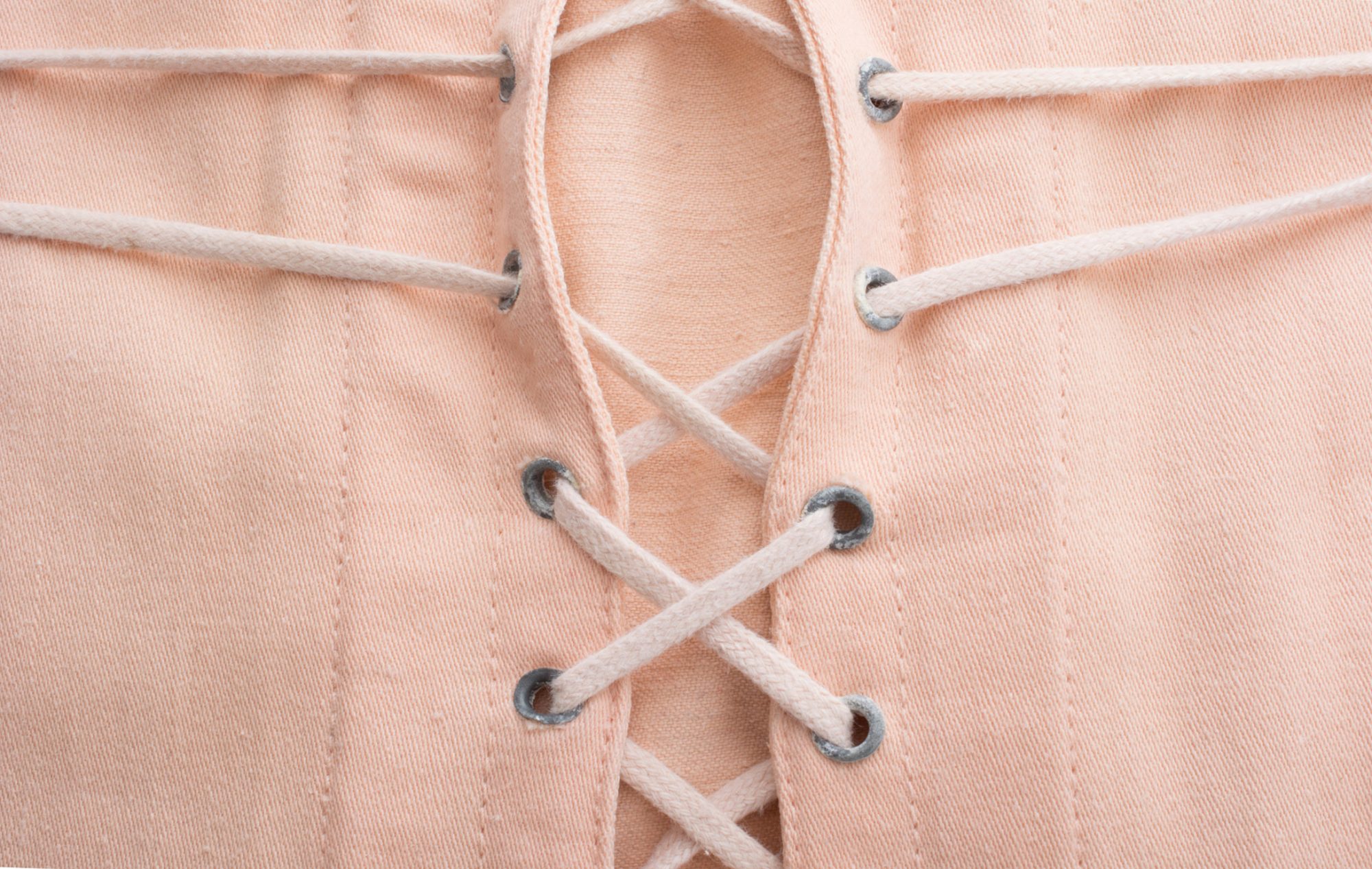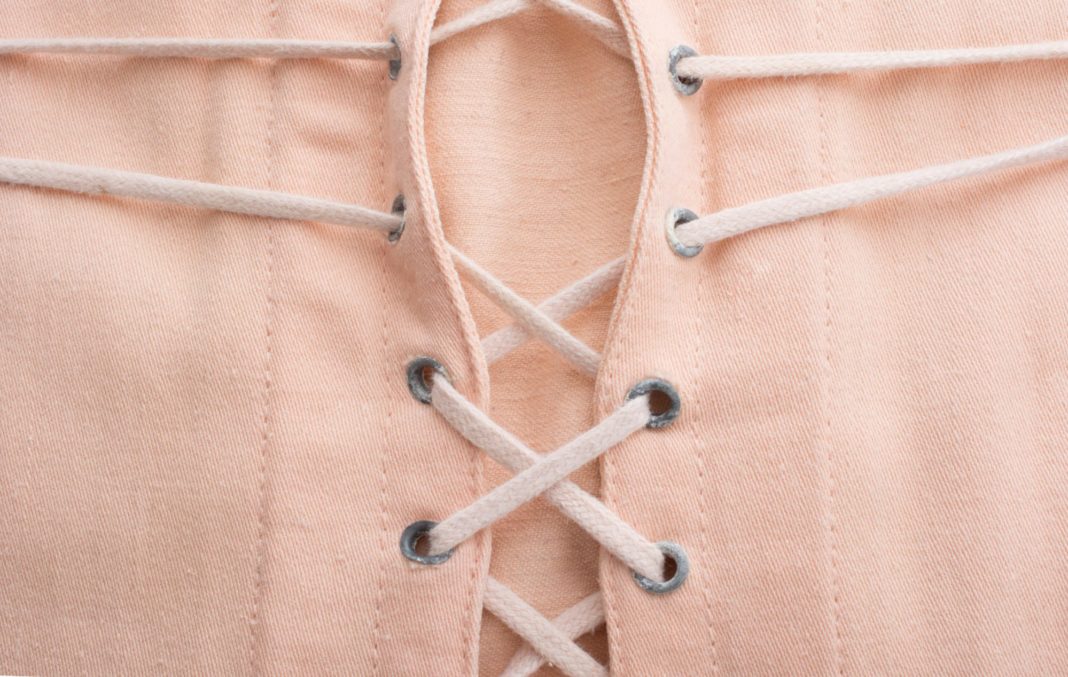
Corsets are having a moment. Bridgerton, Netflix's most popular original series ever, revived interest in the garment earlier this year as part of a rising "cottagecore" trend, and singer Billie Eilish recently "broke the internet" sporting custom corsets in a British Vogue photoshoot. The garment is also all over TikTok: #corset has more than 1.6 billion mentions, and the platform's "corset challenge" features young people cinching their waists, often to shocking proportions.
Apparently, corsets are trending with elementary kids too, because I recently learned that my 8-year-old loves to wear them, virtually, in the popular Roblox game Royale High. In it, players explore the world of a fantasy high school and filling a closet with cool clothes is part of the fun.
I was a bit shocked when she mentioned that corsets made up part of her pixelated wardrobe. For me, the corset represents unrealistic body expectations, oppression, and squished organs. I'm not alone in that thinking, but according to Valerie Steele, director of the Museum at the Fashion Institute of Technology and author of The Corset: A Cultural History, the corset is widely misunderstood and therefore demonized. She describes it as "the most controversial garment in fashion."
So, should parents like me worry about our kids choosing them in virtual games or wearing them in real life? Experts weigh in.
The Health Risks of Corsets
Even though the corsets my daughter sports are virtual, are there actual health risks if she decided to ever put one on? That all depends. "More than 18 hours per day, for weeks to months can cause weakness of the core abdominal and spinal musculature," says Jill Larson, M.D., a pediatric orthopedic surgeon at Ann & Robert H. Lurie Children's Hospital of Chicago.
When laced too tightly, they could also cause fainting or digestive issues, according to Steele.
But what about throwing on a corset for fun? There is low risk of wearing a corset during play, says Dr. Larson. Steele also points out the importance of letting kids wear what they want during imaginary play, which has a bunch of benefits, including fostering creativity, helping kids explore the world, and having therapeutic value.
What About Virtual Corsets?
Parents probably shouldn't be too concerned when kids opt for corsets in a virtual reality either. Jordan Shapiro, Ph.D., author of Father Figure: How to Be a Feminist Dad, says it's important for kids to have ways to safely experiment, and that a child dressing their avatar, a "cartoon version" of themselves, in a corset, doesn't necessarily point to a body image issue.
When asked why she wears them in Royale High, Daphne, 10, from Queens, New York said, "They make you look skinnier so you're not a chunky blob. Also, some of them have designs on them which are very pretty." Does she know what a corset is? "Yes, and I don't want one. They seem very uncomfortable from movies."
It turns out that the primary appeal of the in-game corsets for my daughter, is desirability—as in, you can trade them for even better clothes and accessories. She agreed the designs could be cute but didn't know what a corset did "in real life."
There can also be positive psychological benefits to these video game options. "Research has been done that shows how kids use roleplay games to experiment with identities," says Dr. Shapiro, a senior fellow for the Joan Ganz Cooney Center at Sesame Workshop, an organization advancing children's learning through digital media. "A child can become comfortable with their trans identity because they were able to experiment in Roblox first."
But the pros don't mean that virtual reality can't negatively impact kids. Adopting an avatar that is skinny, or has unrealistic body proportions, may cause or contribute to body image issues, says Renee Engeln, Ph.D., author of Beauty Sick: How the Cultural Obsession with Appearance Hurts Girls and Women. "Girls know Disney princesses aren't real, but that doesn't mean these princesses don't cause girls to internalize the message that being extremely thin and meeting a narrow set of beauty standards will bring success, love, and adulation," she explains.
And it's not just girls who are impacted by idealized depictions of the body. A study published in the journal Sex Roles: A Journal of Research found that both college-aged men and women experienced significantly lower body esteem after playing a video game with idealized physiques (muscular, thin) for just 15 minutes. "In the pantheon of challenges young girls are facing today, video game corsets are not at the top of the list," says Dr. Engeln. "But that doesn't mean we shouldn't care."
What Can Parents Do?
If parents have any concerns about their child's interest in corsets—or any new trend—here's what experts suggest.
Start a conversation
"It's important to talk things through with kids so they can have a sophisticated understanding of things and make their own choices, instead of blindly following what's cool," says Dr. Shapiro. He recommends an open, age-appropriate discussion. You might ask, "Why are corsets exciting to you?" You can also discuss the corset's problematic history, messages about "fat" versus "skinny," and body image.
Dr. Engeln says that communicating the subtle influence of media to kids doesn't have to be that complicated. "You can teach young children to question elements of media culture by framing them as 'silly,'" she suggests. "There's no use lecturing an 8-year-old about the sexualization of girls. But an 8-year-old can respond well to messages like, 'Isn't it silly that the girls in this game wear clothes that look uncomfortable while the boys wear clothes that look comfortable?' Or 'Isn't it silly that the kids in this game all have the same body shape? In real life, bodies come in all shapes and sizes."
For teens who may be more eager to engage in deeper conversations, Dr. Engeln says the key is pivoting from claims about "silliness" to a discussion about "fairness." "Ask teens why video game makers set things up so that girls have to worry about 'looking sexy' even when they're playing a game and just want to have fun. Connect this small issue to broader trends in which girls and young women get pressure to appear sexy to others," she says. But always keep it shame-free. "It's not that it's bad to want to look sexy; lots of people do. The question is who gets to decide what it means to be sexy?" adds Dr. Engeln.
Stacey Rosenfeld, Ph.D., a clinical psychologist specializing in eating disorders and substance use disorders, suggests helping your child imagine the "full and real consequences" of wearing a corset by asking what it would be like to don one while engaging in a favorite activity such as gymnastics or dancing: "Do you think it would be less fun? Do you think it would be harder to breathe?"
Diversify their media
Accept that it's impossible to rid your child's life of corsets or other trends. "We can educate, but we can't restrict access," says Dr. Rosenfeld, who endorses a strategy of "adding-to," rather than subtracting. "Be on the lookout for feminine characters that are valued for something other than their appearance: they're smart, strong, or wise. They're admired for attributes beyond what they look like." With that being said, "diversity in terms of appearance could be helpful as well," adds Dr. Rosenfeld.
She also recommends highlighting a body's agency as a subject, as opposed to a passive object. She names sports as a perfect opportunity to do this. "You might say, 'Look at what her body can do' and stress function over form."
Lead by example
Dr. Rosenfeld encourages parents to accept and fully occupy their own bodies as a way of challenging the mainstream messaging around physical appearance. That could mean being comfortable with the extra pounds you've put on and saying "yes" to opportunities you might have previously declined like sticking around for the group picture.
The Bottom Line
Chances are your kid has come across the corset trend and may even be showing interest in wearing one in real life or virtually. There's no need to panic. Play and dress-up are normal and healthy parts of childhood and adolescence. If you're concerned, engage in an open, age-appropriate dialogue with your child, help them seek out media featuring diverse characters valued for qualities beyond their appearance, and don't forget to reflect on any messaging around appearance or body image you might be communicating with your words or your actions.
































